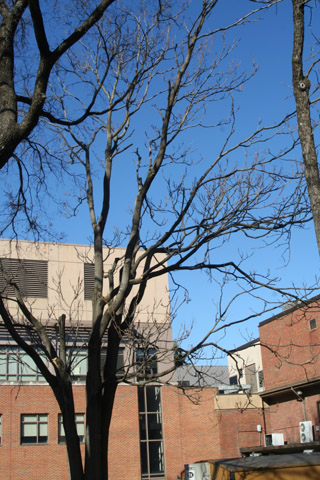
Permanent unique identifier for this particular organism:
http://bioimages.vanderbilt.edu/vanderbilt/7-87
Notes:
This tree grows next to the retaining wall of the Rand loading dock parking lot. It provides a convenient comparison with a black walnut tree that is nearby.
The leaves of tree of heaven have leaflets that have a gland in a notch at the base. Walnut leaflets do not have this gland. The bark of small and medium sized trees is fairly smooth and has vertical whitish streaks, in contrast to the furrowed bark of walnut. Tree of heaven fruits are winged and hang from the tree in large clusters, in contrast to the hard, round nuts of walnuts. Tree of heaven twigs do not have the chambered pith of walnut twigs (please do not cut branches or twigs from trees on the Vanderbilt campus).
Tree of heaven is an introduced species that spreads vigorously and is a problem invasive species in wooded areas. Even when pulled out of the ground, trees will resprout again and again from bits of root left in the ground. It is one of the few trees to thrive in even the most polluted urban areas and will sprout in cracks in sidewalks. It forms thick stands of small trees in vacant lots. It can be truly classified as a weed tree and is despised for the bad smell of its crushed foliage - hence one of its other common names: "stink tree".
The leaves of tree of heaven have leaflets that have a gland in a notch at the base. Walnut leaflets do not have this gland. The bark of small and medium sized trees is fairly smooth and has vertical whitish streaks, in contrast to the furrowed bark of walnut. Tree of heaven fruits are winged and hang from the tree in large clusters, in contrast to the hard, round nuts of walnuts. Tree of heaven twigs do not have the chambered pith of walnut twigs (please do not cut branches or twigs from trees on the Vanderbilt campus).
Tree of heaven is an introduced species that spreads vigorously and is a problem invasive species in wooded areas. Even when pulled out of the ground, trees will resprout again and again from bits of root left in the ground. It is one of the few trees to thrive in even the most polluted urban areas and will sprout in cracks in sidewalks. It forms thick stands of small trees in vacant lots. It can be truly classified as a weed tree and is despised for the bad smell of its crushed foliage - hence one of its other common names: "stink tree".
 |  |
Load database and switch to thumbnail view
Use this stable URL to link to this page:
http://bioimages.vanderbilt.edu/vanderbilt/7-87.htm
This organism is a living specimen that is part of the Vanderbilt University Arboretum with the local identifier 3-192.
This particular organism is believed to have managedmeans of establishment.
This organismal entity has the scope: multicellular organism.
Remarks:Cut down by 2014.
Identifications:
Ailanthus altissima
(Mill.) Swingle
sec. Gleason Cronquist 1991
common name: tree of heaven
family: Simaroubaceae
Identified 2002-09-09 by Steven J. Baskauf
Location:
Nashville, Davidson County, Tennessee, US
Click on these geocoordinates to load a map showing the location: 36.14604°, -86.80326°
Coordinate uncertainty about: 10 m.
Location determined from Google maps.
Occurrences were recorded for this particular organism on the following dates:
2002-09-09
2005-04-08
2006-06-08
2013-12-11
2014-09-03
The following images document this particular organism.
Click on a thumbnail to view the image and its metadata.Load database and enable navigation by taxon and organism.











